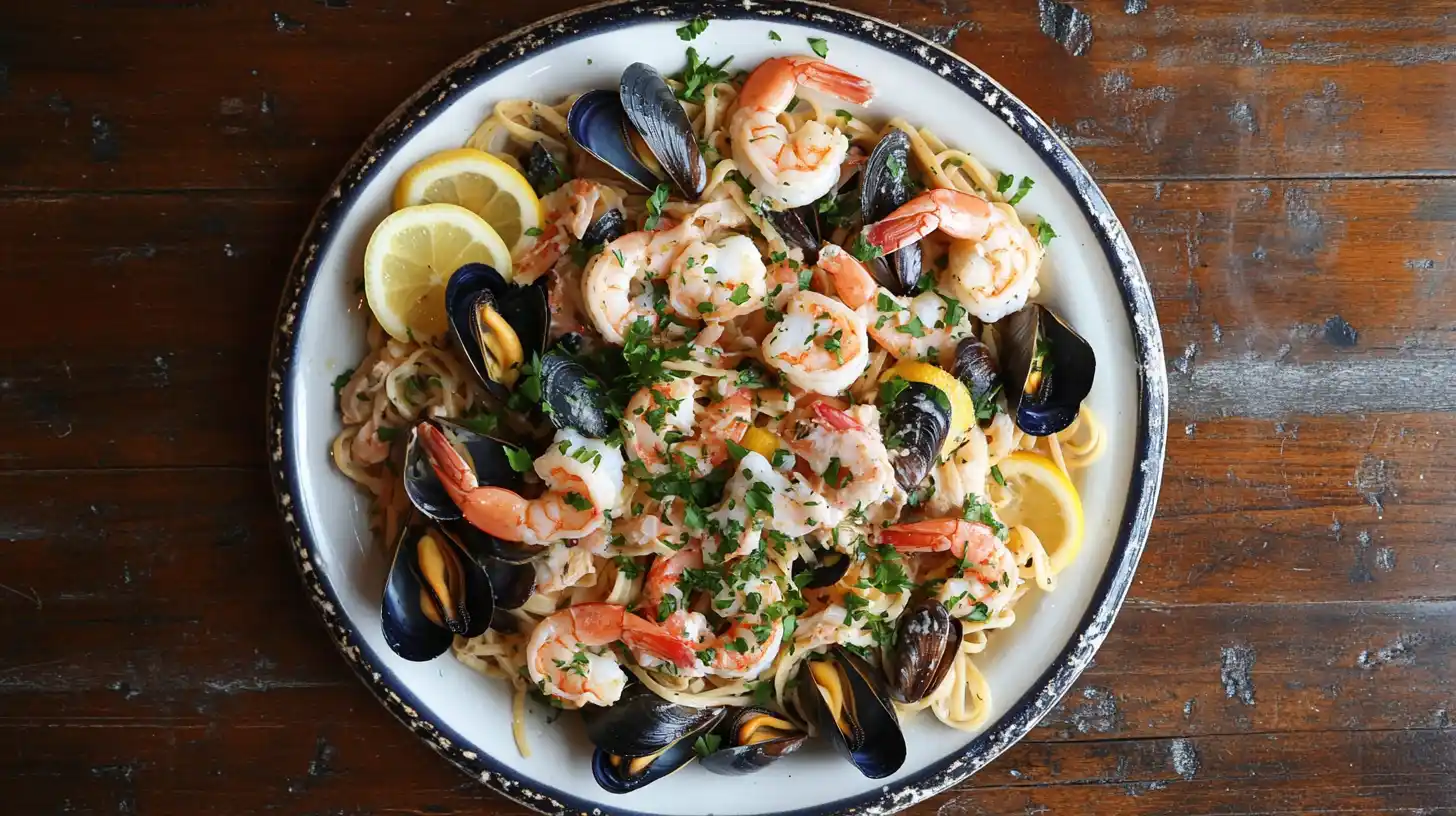Craving seafood pasta that tastes straight out of a seaside restaurant? With these quick pro tips, you’ll nail it every time fresh, flavorful, and perfectly cooked without ever going overboard.
Table of contents
- Why You’ll Love This Seafood Pasta
- Ingredients for the Best Seafood Pasta
- Step-by-Step Instructions for Perfect Seafood Pasta
- Pro Tips for the Perfect Seafood Pasta Every Time
- Variations of Seafood Pasta to Try at Home
- 1. Classic Spaghetti alle Vongole (Spaghetti with Clams)
- 2. Lobster Mac and Cheese
- 3. Spicy Shrimp Pasta with Tomato-Garlic Sauce
- 4. Creamy Crab Linguine with Lemon and Capers
- 5. Squid Ink Pasta with Shrimp and Calamari
- 6. Thai-Inspired Spicy Seafood Noodles
- Bonus Table: Quick-Glance at Popular Variations
- Common Mistakes to Avoid When Making Seafood Pasta
- How to Store and Reheat Seafood Pasta (Without Ruining It)
- What to Serve with Seafood Pasta
- Frequently Asked Questions
- Conclusion
Why You’ll Love This Seafood Pasta
Let’s be honest what’s not to love about seafood pasta?
Think of it as the ultimate match: the ocean’s freshest flavors paired with the comfort of hearty pasta. Whether you’re out to impress guests or simply upgrade a weeknight meal, seafood pasta always delivers.
The Allure of Seafood Pasta: Fresh, Flavorful, and Elegant
Imagine this: succulent shrimp sizzling in garlicky olive oil, clams releasing their briny sweetness, all twirled into perfectly al dente linguine. Sounds like restaurant fare, right? The best part you can recreate it at home, no culinary degree required. Seafood pasta is at once light and indulgent, bursting with flavor. One bite transports you straight to the Italian coast, and with just a few simple tricks, you’ll be cooking it like a pro.
A Crowd-Pleaser for Every Occasion
This dish isn’t just delicious it’s a total crowd-pleaser. Need a romantic dinner idea? Done. Hosting family and want something elegant that doesn’t take hours to make? Boom. Seafood pasta is versatile. It plays nice with different types of seafood, pasta shapes, and sauces. Whether you’re into creamy, spicy, or zesty flavors, there’s a seafood pasta recipe with your name on it.
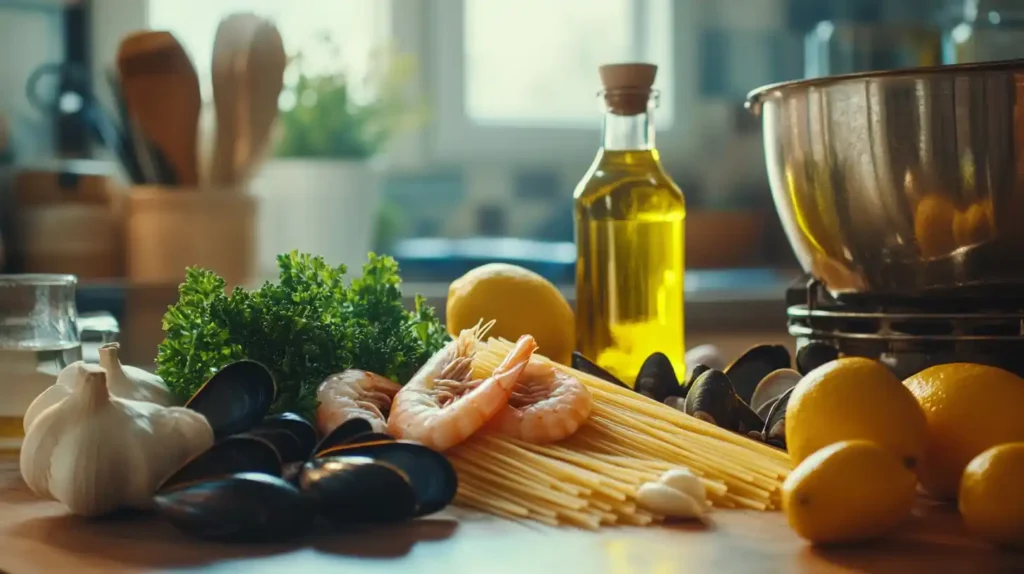
Ingredients for the Best Seafood Pasta
Okay, let’s talk ingredients. This is where the magic starts. When it comes to seafood pasta, fresh and quality matter a lot. You don’t need a million items just the right ones.
Ingredient Table – Basic Seafood Pasta (Garlic Olive Oil Style)
| Ingredient | Quantity |
|---|---|
| Spaghetti or linguine | 400g (14 oz) |
| Shrimp (peeled) | 200g (7 oz) |
| Mussels or clams | 200g (7 oz) |
| Olive oil | 3 tbsp |
| Garlic (sliced) | 4 cloves |
| Crushed red pepper | 1/2 tsp (optional) |
| White wine | 1/3 cup |
| Lemon (zest & juice) | 1 |
| Fresh parsley | 2 tbsp (chopped) |
| Salt | To taste |
| Black pepper | To taste |
Essential Seafood Choices
Here’s where you can play around. Some of the best seafood for pasta includes:
- Shrimp – Cooks fast, absorbs flavor like a sponge.
- Clams & Mussels – Bring a natural saltiness and dramatic flair.
- Crab – Sweet, soft, and luxurious. Perfect for creamy versions.
- Scallops – Super tender and quick-cooking.
- Lobster – Decadent and celebratory. Go big or go home.
Fresh is best, but frozen works too just make sure it’s high-quality. If you’re not sure how to clean mussels or prep shrimp, don’t sweat it we’ll walk you through that in the next section.
Choosing the Right Pasta
Seafood pasta loves long noodles. Think spaghetti, linguine, fettuccine, or bucatini. These give the sauce and seafood plenty of space to shine.
But don’t be afraid to switch it up:
- Orzo is great for risotto-style seafood dishes.
- Cavatelli or shells trap bits of sauce and tiny seafood like baby shrimp or crab meat.
Flavor Builders: Garlic, Olive Oil, Herbs, and Citrus
If seafood is the heart of the dish, then your flavor builders are the soul. Here are a few non-negotiables:
- Garlic – The ultimate seafood pasta sidekick.
- Extra Virgin Olive Oil – Rich, silky, and essential.
- Fresh herbs – Parsley, basil, dill… choose your vibe.
- White wine – A splash of acidity to brighten everything.
- Lemon – Zest + juice = magic.
Want to kick it up a notch? Add anchovies for umami, capers for tang, or crushed red pepper for a little heat.
Optional Add-Ins to Customize Your Dish
You can go full traditional or add your own twist:
- Cherry tomatoes for a light sauce.
- Heavy cream or butter for richness.
- Parmesan or Pecorino Romano (though some seafood purists say no cheese with fish we’ll let you decide).
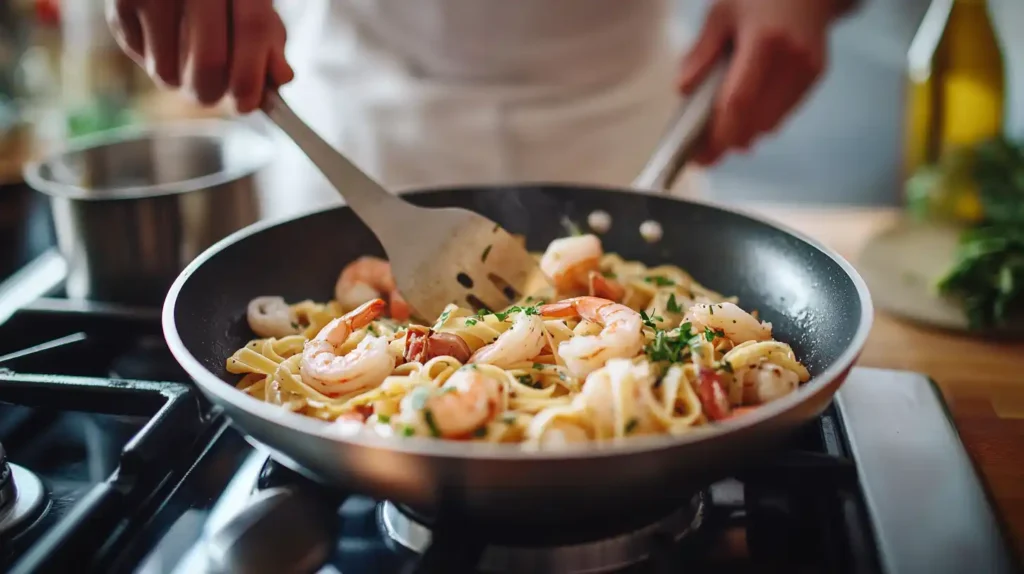
Step-by-Step Instructions for Perfect Seafood Pasta
Alright, time to get cooking! Think seafood pasta is only for restaurant chefs? Think again. I’ll guide you step by step and it’s easier than you think.
Step 1: Prep Your Seafood
Before anything hits the pan, let’s prep like pros.
- Shrimp: Peel and devein them (if they aren’t already). If you’re short on time, pre-cleaned frozen shrimp is totally fine just thaw and pat dry.
- Clams and Mussels: Rinse them under cold water. Tap any that are open if they don’t close up, toss them (they’re not fresh). Scrub their shells and remove beards if you’re using mussels.
- Crab Meat or Lobster: If you’re using these fancier options, make sure the meat is clean and shell-free. You can also buy pre-cooked versions to make life easier.
Step 2: Cook the Pasta (But Not All the Way)
Bring a large pot of salted water to a boil. It should taste like the ocean trust me, this matters.
- Drop in your pasta and cook it about 1–2 minutes less than the package instructions. Why? Because it’s going to finish cooking in the sauce. That’s how you get those flavors to really soak in.
- Save 1 cup of the pasta water before you drain it. This starchy liquid gold helps bind the sauce later.
Time-saving tip: You can do all your chopping and prep while the pasta’s boiling.
Step 3: Build the Sauce Base
Now it’s time to get your pan sizzling.
- Heat 3 tablespoons of olive oil over medium heat.
- Add sliced garlic and cook until it’s golden and fragrant but not burned. (Burnt garlic = bitter disaster.)
- If you like a little heat, toss in a pinch of crushed red pepper flakes.
- Pour in about 1/3 cup of white wine, and let it simmer until it reduces slightly this is your flavor foundation.
Optional: Add zest of one lemon here for an extra bright note.
Step 4: Add the Seafood
Let’s get those ocean flavors rolling.
- Start with the clams and mussels (if using). Cover the pan and cook for 4–6 minutes until they open up. Discard any that stay shut.
- Add shrimp, scallops, or any quick-cooking seafood. Cook until just opaque this only takes about 2–4 minutes.
- For pre-cooked crab or lobster, just warm it through at the end.
The seafood rule: Don’t walk away! It cooks fast and hates being overdone.
Step 5: Toss It All Together
Now for the fun part bringing it all together.
- Add your drained pasta directly to the pan.
- Toss everything together, adding a splash of the reserved pasta water to loosen things up and create a silky sauce.
- Finish with fresh chopped parsley, black pepper, and a squeeze of lemon juice.
- Optional: A sprinkle of Parmesan (if you’re into that sorta thing).
Your seafood pasta is DONE. Grab a fork, twirl up a bite, and taste the sea (in the best way possible).
Pro Tips for the Perfect Seafood Pasta Every Time
Okay, you’ve got the steps down but if you want your seafood pasta to go from good to chef’s kiss, these pro tips are where it’s at.
1. Timing is Everything
This might be the golden rule of seafood pasta. Seafood is delicate. It can go from plump and juicy to dry and chewy faster than you can say “buon appetito.”
- Shrimp? 2–3 minutes.
- Scallops? 2–4 minutes.
- Clams/Mussels? 5–7 minutes.
- Lobster/Crab (pre-cooked)? Just heat it through no more than a minute or two.
If you’re using multiple types of seafood, add them in stages, based on how long they take to cook.
2. Use the Pasta Water Like a Boss
You know that cloudy, starchy water you saved? That’s your secret sauce fixer. It helps the oil, wine, and seafood juices cling to the pasta. Add it a little at a time while tossing everything together. It’s like a magic glue that brings your dish together.
Don’t overdo it a few tablespoons at a time is usually enough.
3. Don’t Overcrowd the Pan
Trying to cook too much seafood in one pan = steamed, soggy sadness. Cook in batches if needed, especially for larger amounts. Searing is key to flavor.
4. Choose Quality Olive Oil and Wine
Simple recipes like seafood pasta rely on high-quality ingredients. Use extra virgin olive oil for depth and richness, and go for a dry white wine you’d actually drink like Pinot Grigio or Sauvignon Blanc.
Avoid cooking wine from a bottle with a screw top that’s been in your pantry since 2007. You deserve better.
5. Add Layers of Freshness at the End
Just before serving, hit the pasta with a bit more:
- Lemon juice or zest – for that bright zing.
- Chopped herbs – parsley is classic, but basil or dill can also shine.
- Freshly cracked pepper – makes all the difference.
6. Want Creamy Sauce? Do It the Right Way
If you’re craving a creamy seafood pasta, add:
- A splash of cream after the wine reduces, or
- A dollop of butter at the end to emulsify the sauce.
Just don’t drown the seafood. Cream should complement, not cover.
7. Let the Pasta Rest (a Little)
Yep, pasta benefits from a short “rest” after mixing. Give it 2 minutes in the pan, off the heat, so it absorbs more of the flavors. It’s like letting it soak in the hot tub before hitting your plate.
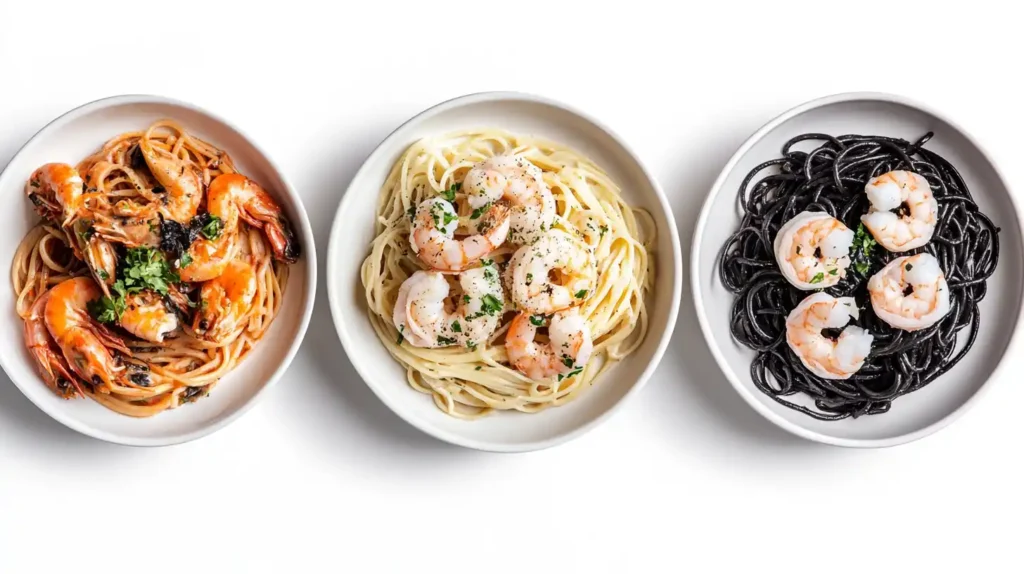
Variations of Seafood Pasta to Try at Home
One of the best things about seafood pasta? It’s a blank canvas with endless flavors from creamy to spicy, zesty to garlicky. Let’s explore some tasty variations you can try at home!
1. Classic Spaghetti alle Vongole (Spaghetti with Clams)
Spaghetti alle Vongole is a true Italian classic simple and full of flavor. Just clams, garlic, olive oil, white wine, parsley, and spaghetti. The magic? When the clams open, they release a briny juice that becomes a light, silky sauce.
Perfect for: Date nights, minimal-effort meals that taste fancy.
Pro twist: Add a pinch of chili flakes for a little heat, or finish with lemon zest to brighten things up.
2. Lobster Mac and Cheese
Now we’re talking indulgence. This isn’t boxed mac and cheese it’s a rich, grown-up version with creamy cheese and sweet lobster chunks. Shell pasta or elbows catch all that gooey goodness, while a mix of Fontina, Gruyère, and cheddar takes it to the next level.
Perfect for: Special occasions, comfort food cravings, or impressing guests.
Optional upgrade: Make a breadcrumb topping with garlic and herbs, then bake until golden.
3. Spicy Shrimp Pasta with Tomato-Garlic Sauce
This one’s full of zing. Start with garlic, onions, crushed tomatoes, white wine, and red pepper flakes. Add shrimp and cook until pink. Bold, punchy, and ready in 30 minutes.
Perfect for: Weeknight dinners, spice lovers, meal-prep champs.
Flavor boost: Add fresh basil and a sprinkle of Parmesan if you want to mellow out the spice.
4. Creamy Crab Linguine with Lemon and Capers
This one’s pure elegance. Lump crab, butter, capers, lemon juice, and a splash of cream create a silky sauce that coats linguine beautifully. Light yet rich, it’s perfectly balanced with a touch of tang and saltiness.
Perfect for: Summer evenings, light lunches, white wine pairings.
Pro tip: Use real lemon juice and zest bottled just doesn’t cut it here.
5. Squid Ink Pasta with Shrimp and Calamari
Want to feel like you’re dining seaside in Spain or Italy? Squid ink pasta brings bold flavor and drama, pairing perfectly with tender calamari and shrimp. Toss it in a garlicky white wine sauce and just like that, you’re a gourmet chef.
Perfect for: Dinner parties, culinary adventures, date nights.
Chef’s tip: Serve with a glass of chilled Prosecco for a true restaurant vibe.
6. Thai-Inspired Spicy Seafood Noodles
It’s not traditional Italian, but it’s a must-try. Shrimp, scallops, or mussels in a creamy coconut red curry sauce tossed with noodles. Add basil, lime, and fish sauce for a bold, flavorful fusion twist.
Perfect for: When you’re craving something exotic and cozy.
Spice level: Control the heat with more or less curry paste.
Bonus Table: Quick-Glance at Popular Variations
| Variation | Seafood Used | Sauce Type | Pasta Type | Vibe |
|---|---|---|---|---|
| Spaghetti alle Vongole | Clams | White wine, oil | Spaghetti | Light & traditional |
| Lobster Mac and Cheese | Lobster | Creamy cheese | Macaroni | Rich & indulgent |
| Spicy Shrimp Pasta | Shrimp | Tomato & garlic | Linguine | Bold & spicy |
| Crab Linguine with Capers | Crab | Butter, lemon | Linguine | Elegant & tangy |
| Squid Ink Pasta with Calamari | Squid, Shrimp | White wine, oil | Squid ink pasta | Gourmet & dramatic |
| Thai-Inspired Noodle Bowl | Shrimp, Mussels, Scallops | Coconut curry | Rice noodles | Fusion & flavorful |
Common Mistakes to Avoid When Making Seafood Pasta
Now that you’re craving seafood pasta, let’s avoid the common mistakes that can ruin it. Don’t worry we’ve got your back!
1. Overcooking the Seafood
This is probably the #1 seafood sin.
Shrimp turn rubbery, scallops go chewy, and mussels become sad little blobs if left on the heat too long.
Fix: Cook seafood just until done. It should still be tender and juicy. If in doubt, pull it off the heat a minute early it’ll keep cooking in the hot pasta.
2. Adding Seafood Too Early
Similar to overcooking, this one happens when you throw everything in at once. Different seafood cooks at different speeds!
Shrimp needs 2–3 minutes, mussels may need 5–7, and pre-cooked crab or lobster just needs to be warmed.
Fix: Cook in stages based on what you’re using. Shrimp goes in last. Mussels and clams go in early, so they have time to open.
3. Using the Wrong Pasta
Sorry rigatoni you’re not invited to this party.
Seafood pasta thrives with long noodles that soak up sauce and mingle nicely with tender bites of seafood.
Fix: Stick with spaghetti, linguine, or fettuccine. If you’re using shellfish-heavy recipes, orzo or small shells also work great.
4. Drowning Everything in Cream
Creamy sauces are delish but too much cream buries the flavor of delicate seafood. Plus, it can make your dish feel too heavy.
Fix: Use just enough cream or butter to enhance, not overwhelm. A little goes a long way.
5. Forgetting to Save Pasta Water
This one hurts, especially when your sauce won’t stick and everything’s dry.
That starchy pasta water is liquid gold it helps your sauce cling, balances texture, and gives your dish restaurant-level silkiness.
Fix: Always reserve at least 1 cup of pasta water before draining. Thank us later.
6. Going Overboard with Cheese
We get it cheese is life. But in seafood pasta? Less is more. Some traditionalists even say no cheese with seafood at all. We won’t go that far, but moderation is key.
Fix: If you do want cheese, go with a light dusting of Parmesan or Pecorino Romano at the end. Not in the sauce.
7. Ignoring Fresh Ingredients
Using bottled lemon juice, pre-minced garlic, or low-quality seafood? That’s like putting ketchup on a steak.
Fix: Use fresh, real ingredients. It’s a simple dish every ingredient has a spotlight.
How to Store and Reheat Seafood Pasta (Without Ruining It)
Made a big batch of seafood pasta? Leftovers are great but only if stored right. Seafood can spoil fast, so here’s how to keep it fresh and tasty.
Storing Seafood Pasta the Right Way
Whether it’s shrimp linguine or lobster mac, these rules apply to all types of seafood pasta:
- Cool it quickly: Don’t leave it sitting out for more than 1 hour. Bacteria love warm seafood.
- Use airtight containers: Store in a glass or BPA-free plastic container with a tight seal.
- Fridge life: You can store seafood pasta in the refrigerator for up to 2 days. After that, it starts getting sketchy.
- Label it: If you’ve got multiple leftovers in the fridge, slap on a label with the date. Future you will thank you.
Can You Freeze Seafood Pasta?
Technically? Yes.
Would I recommend it? Only some versions.
Creamy seafood pastas don’t freeze well they tend to separate and get grainy. Same goes for dishes with delicate shellfish like scallops or mussels. But heartier ones, like shrimp in tomato sauce or crab mac and cheese, freeze better.
To freeze:
- Let it cool completely.
- Portion into freezer-safe containers or zip bags.
- Label and date.
- Freeze for up to 2 month for best taste.
To thaw, move it to the fridge overnight. Never defrost seafood pasta at room temperature it invites bacteria to the party.
How to Reheat Without Overcooking
Here’s the golden rule: low and slow.
Microwaves are fast but they tend to nuke seafood into rubbery sadness. So if you must microwave, follow these steps:
- Add a splash of water, broth, or olive oil to the pasta to loosen it up.
- Cover with a microwave-safe lid or plate to trap moisture.
- Heat on 50% power in 40-second intervals, stirring gently.
For the best results, reheat on the stovetop:
- Put the pasta in a nonstick skillet.
- Add a splash of water or broth.
- Cover with a lid and warm over medium-low heat, stirring now and then until hot.
Once warm, feel free to finish with a little fresh lemon juice, parsley, or even a drizzle of olive oil to wake up the flavor again.
What to Serve with Seafood Pasta
- Mushroom Spinach Pasta: Earthy, herby, and a natural partner to seafood.
- Broccoli Cauliflower Salad: Creamy, crunchy, and veggie-packed.
- Crawfish Cornbread: A Southern twist that complements the seafood theme.
- Salmon Sandwich Guide: Seafood-on-seafood? Yes, if you like it rich.
Frequently Asked Questions
1. What is the best seafood to use in pasta?
The best seafood for pasta includes shrimp, clams, mussels, scallops, crab, and lobster. These options cook quickly and pair well with a variety of sauces whether it’s light and garlicky or rich and creamy. Choose what’s fresh or available locally for the best flavor.
2. Can you reheat seafood pasta safely?
Yes, but do it carefully to avoid overcooking. Reheat gently on the stove with a splash of water or broth, or microwave in short bursts at 50% power. Only reheat once and eat within 1–2 days of storing it in the fridge.
3. What sauce goes best with seafood pasta?
Seafood pasta shines with light sauces like garlic and olive oil, white wine, lemon butter, or light tomato sauce. Creamy sauces also work well, especially with crab or lobster, but should be used in moderation so the seafood flavor still stands out.
4. Is cheese okay to use in seafood pasta?
Yes, but lightly! While traditional Italian cooking avoids cheese with seafood, a sprinkle of Parmesan or Pecorino can enhance flavor especially in creamy or tomato-based pasta. Just don’t overdo it, so you don’t overpower the seafood.
Conclusion
Seafood pasta is more than just a delicious dinner it’s a perfect mix of comfort and flavor with a hint of elegance. Whether you’re using shrimp, crab, mussels, or lobster, this dish brings the taste of the ocean straight to your table.
The beauty of seafood pasta is how flexible it is. You can keep it light with olive oil and lemon, spice it up with chili flakes, or go rich and creamy with a buttery sauce. Once you master the basics, the variations are endless.
So the next time you’re thinking of what to cook for dinner, make it seafood pasta. It’s simple, satisfying, and guaranteed to impress no matter your skill level in the kitchen.
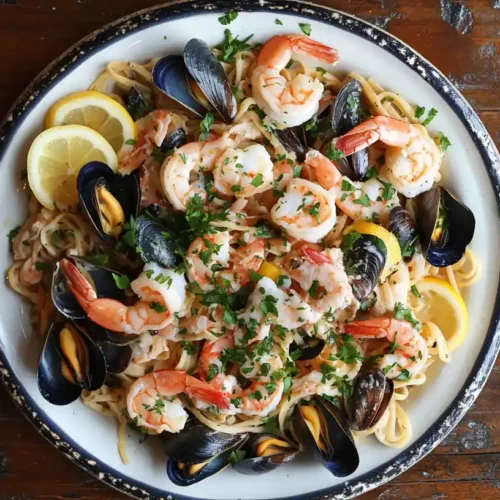
Seafood Pasta with Garlic Olive Oil
Equipment
- Large Pot
- Large skillet or sauté pan
Ingredients
Seafood Pasta
- 400 g spaghetti or linguine
- 200 g shrimp peeled
- 200 g mussels or clams
- 3 tbsp olive oil
- 4 cloves garlic sliced
- 1/2 tsp crushed red pepper optional
- 1/3 cup white wine
- 1 lemon zest and juice
- 2 tbsp fresh parsley chopped
- salt to taste
- black pepper to taste
Instructions
- Peel and prep shrimp, and clean mussels or clams. Discard any that do not close when tapped.
- Boil salted water and cook pasta 1–2 minutes less than package instructions. Reserve 1 cup of pasta water.
- In a skillet, heat olive oil over medium. Sauté garlic until golden. Add red pepper flakes if using.
- Pour in white wine and simmer until reduced slightly. Add lemon zest if desired.
- Add clams or mussels, cover and cook until they open (4–6 minutes). Add shrimp and cook until opaque.
- Toss drained pasta with seafood mixture, adding pasta water to loosen. Finish with parsley, lemon juice, and black pepper.

